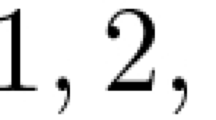Summary
We investigate the continuous and measurable solutions of the system of Abel's functional equations
and their applications to the iteration theory. Let us assume the following hypothesis: (H)f, g: (a, b) → (a, b) are continuous bijections andf º g = g º f. Moreoverf n (x) ≠ g m (x) for everyx∈(a, b) and everyn, m ∈ ℤ such that |n| + |m| ≠ 0.
LetL be the set of limit points of {f n º g m (x): n, m ∈ ℤ}, wherex ∈(a, b) (L does not depend ofx). The setL is either a perfect and nowhere dense set orL = 〈a, b〉.
Theorem.If f and g satisfy hypothesis (H), then there is a unique s ∈ ℝ such that the system (1) has a continuous solution. For this s the system (1) has a continuous solution ϕ unique up to an additive constant. This solution ϕ is monotonic, ϕ[L ⋂ (a, b)] = ℝ and s is irrational. Moreover ϕ is invertible if and only if L = 〈a, b〉.
Corollary.Let f and g satisfy hypothesis (H). Then there exists a continuous iteration group {f t t} such that ft 1 =f and g ∈ {f t } if and only if L = 〈a, b〉. Moreover this iteration group is unique.
Further let us assume the following hypothesis:
(C)f, g: (a, b) →(a, b) are continuous bijections such thatf(x) ≠ x, g(x) ≠ x forx ∈(a, b), fºg=gºf andf n =g m for somen, m ∈ ℤ\{0}.
Theorem.Let hypothesis (C) be fulfilled. Then the system (1) for s = n/m has a continuous and invertible solution. This solution depends on an arbitrary function.
Corollary.Let f and g satisfy hypothesis (C), then there exist infinitely many continuous iteration groups {f t } such that f 1 =f and g ∈ {f t }.
Similar content being viewed by others
References
Birkhoff, G. andMacLane, S.,A survey of modern algebra. McMillan, New York, 1954.
Ger, R., Kominek, Z. andSablik, M.,Generalized Smital's lemma and a theorem of Steinhaus. Rad. Mat.1 (1985), 101–119.
Kuczma, M.,Functional equations in a single variable. PWN-Polish Scientific Publishers, Warszawa, 1968.
Lomnicki, A.,O wielookresowych funkcjach jednoznacznych zmiennej rzeczywistej. Sprawozdania Tow. Nau. Warsz. Rok XI6 (1918), 808–846.
Midura, S.,Sur les solutions de l'équation de translation. Aequationes Math.1 (1968), 77–84.
Targonski, GY.,Topics in iteration theory. Vanderhoeck & Ruprecht, Göttingen, 1981.
Walters, P.,An introduction to ergodic theory. (Graduate Texts in Math., No. 79). Springer-Verlag, New York—Heidelberg—Berlin, 1982.
Zdun, M. C.,Note on commutable functions. Aequationes Math.36 (1988), 153–164.
Author information
Authors and Affiliations
Rights and permissions
About this article
Cite this article
Zdun, M.C. On simultaneous Abel equations. Aeq. Math. 38, 163–177 (1989). https://doi.org/10.1007/BF01840002
Received:
Accepted:
Issue Date:
DOI: https://doi.org/10.1007/BF01840002




